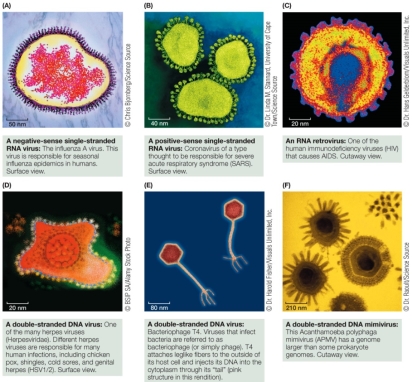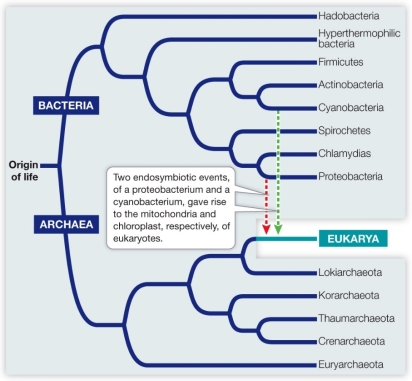Correct Answer

verified
Correct Answer
verified
Short Answer
The group of bacteria least likely to be affected by antibiotics targeting peptidoglycan is the mycoplasma group, which belongs to the _______ class of bacteria.
Correct Answer

verified
Correct Answer
verified
Multiple Choice
Which statement regarding the forces that shaped the evolution of Bacteria and Archaea is false?
A) Mutations are an important source of variation.
B) Lateral gene transfer has played a role in the evolution of the prokaryotic groups.
C) Prokaryotes can acquire new alleles through the process of conjugation.
D) Mutations in prokaryotes have an immediate impact on the cell.
E) Lateral gene transfer in prokaryotes occurs only through the process of transduction.
Correct Answer

verified
Correct Answer
verified
Multiple Choice
Refer to the figure, which shows a variety of viruses.  What do all of the viruses have in common?
What do all of the viruses have in common?
A) They all have DNA as genetic material.
B) They all have RNA as genetic material.
C) They all are infectious.
D) They all infect eukaryotes.
E) They all possess enzymes for making mRNA from their genetic material.
Correct Answer

verified
Correct Answer
verified
Multiple Choice
Which statement about viruses is false?
A) There are more viruses on Earth than there are cellular organisms.
B) Blooms of marine bacteria are short-lived because of bacteriophages.
C) Bacteriophages can diminish the severity of certain bacterial illnesses in humans.
D) Some viruses are able to replicate outside of a living host cell.
E) Some viruses can store their genetic information in the form of RNA.
Correct Answer

verified
Correct Answer
verified
Multiple Choice
Which statement about prokaryotic archaea is false?
A) They can live in harsh environments.
B) Their cell walls lack peptidoglycan.
C) They are unlike most bacteria.
D) Their ribosomes share characteristics with bacteria.
E) They make up a recently evolved group.
Correct Answer

verified
Correct Answer
verified
Multiple Choice
Which of the following is not a characteristic of prokaryotic cells?
A) A membrane-enclosed nucleus
B) A photosynthetic membrane system
C) Peptidoglycan
D) Circular DNA
E) Ribosomes
Correct Answer

verified
Correct Answer
verified
Short Answer
A group of parasites that are among the smallest of the bacteria, called the _______, have a complex intracellular life cycle.
Correct Answer

verified
Correct Answer
verified
Multiple Choice
Which of the following is not an ecological effect of viruses?
A) Huge marine blooms of bacteria, such as of Vibrio, are short-lived because bacteriophage viral blooms soon follow and kill bacteria faster than they can reproduce.
B) Cholera epidemics caused by a species of Vibrio fade because bacteriophages multiply and control the Vibrio population boom.
C) Viruses are abundant in both marine and freshwater environments and have a large effect on the ecology of these ecosystems.
D) One-half of the bacteria in the oceans are killed by viruses every day.
E) Viruses constitute an important source of nutrition for the many prokaryote species that consume them.
Correct Answer

verified
Correct Answer
verified
Short Answer
If cattle and rice cultivation were dramatically reduced, there would likely be a decrease in greenhouse gases due to a reduction in _______ available to produce methane.
Correct Answer

verified
Correct Answer
verified
Multiple Choice
Refer to the figure.  According to these data, evidence that mimiviruses are derived from reduced parasitic symbionts includes the
According to these data, evidence that mimiviruses are derived from reduced parasitic symbionts includes the
A) size and composition of the mimivirus genome relative to other organisms.
B) the similarities between the mimivirus and free-living bacteria.
C) types of genes found in the mimivirus genome.
D) size of the mimivirus alone.
E) fact that mimiviruses have a double-stranded DNA genome.
Correct Answer

verified
Correct Answer
verified
Multiple Choice
Which of the following has been used as a bioterrorism agent, utilizing the fact that large quantities of its endospores are relatively easy to transport and spread among human populations, where they may be inhaled or ingested?
A) Mycobacterium tuberculosis
B) Bacillus anthracis
C) Clostridium
D) Streptomyces
E) Staphylococcus aureus
Correct Answer

verified
Correct Answer
verified
Short Answer
Antibiotics such as penicillin have little, if any, effect on the cells of eukaryotes, because they work by interfering with the synthesis of cell walls containing _______.
Correct Answer

verified
Correct Answer
verified
Multiple Choice
The common ancestry (monophyly) of all of life is confirmed by
A) the similar appearances of organisms in all major groups.
B) ample fossil evidence.
C) DNA as the genetic material that codes for proteins.
D) the presence of specialized cell membrane infoldings.
E) the biochemical similarities in membrane composition.
Correct Answer

verified
Correct Answer
verified
Multiple Choice
Refer to the figure.  According to the depiction of the endosymbiotic origin of eukaryotic chloroplasts, which statement is correct?
According to the depiction of the endosymbiotic origin of eukaryotic chloroplasts, which statement is correct?
A) Bacteria are more closely related to Eukarya than to Archaea.
B) The common ancestor of Archaea and Eukarya possessed chloroplasts.
C) Some archaea possess chloroplasts.
D) Mammals possess chloroplasts, which become functional during starvation.
E) In the Eukarya, chloroplasts have their own DNA.
Correct Answer

verified
Correct Answer
verified
Multiple Choice
Most diseases caused by viruses are caused by _______.These diseases include polio, hepatitis C, and the common cold.In plants, these viruses kill patches of cells in the leaves or stems of plants, leaving live cells amid a patchwork of discolored dead tissue, giving them the name "mosaic" or "mottle" viruses.
A) DNA viruses
B) negative-sense single-stranded RNA viruses
C) double-stranded RNA viruses
D) positive-sense single-stranded RNA viruses
E) RNA retroviruses
Correct Answer

verified
Correct Answer
verified
Multiple Choice
Which is/are the closest monophyletic group(s) to the Bacteria?
A) Eukarya
B) A subset of Eukarya
C) Archaea (including eukaryotes)
D) Bacteria plus Eukarya
E) Prokaryotes
Correct Answer

verified
Correct Answer
verified
Multiple Choice
The phylogeny of prokaryotes
A) reveals that spirochetes are the most ancient existing bacterial species.
B) is completely resolved.
C) is easily understood, because of the phenomenon of lateral gene transfer.
D) is now based on gene sequences.
E) reveals that the Archaea and Bacteria do not share a common ancestor.
Correct Answer

verified
Correct Answer
verified
Multiple Choice
The sequencing of rRNA allowed scientists a clear understanding
A) of the unambiguous relationships among different prokaryotic species.
B) that certain nucleic acid sequences are unique to archaea and eukaryotes.
C) that archaea are more similar to bacteria than to eukaryotes.
D) that all DNA is relatively the same across domains.
E) that half of the sequences of archaea were previously unknown.
Correct Answer

verified
Correct Answer
verified
Multiple Choice
A consensus tree summarizing the evolutionary relationships among organisms consists of a phylogenetic tree
A) based on morphological characteristics only.
B) that uses data from multiple gene sequences.
C) showing lateral gene transfer for a single gene.
D) based on a single DNA sequence.
E) based solely on rRNA sequence.
Correct Answer

verified
Correct Answer
verified
Showing 181 - 200 of 262
Related Exams